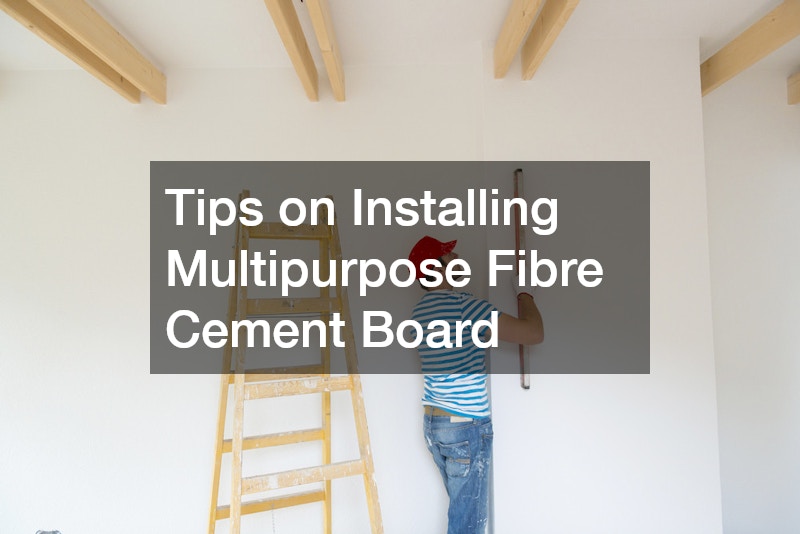Disclaimer: Benro Properties. This site provides home improvement content for informational purposes only.
Fibre cement board is a versatile building material used for a variety of applications in both residential and commercial construction. Known for its durability, fire resistance, and moisture resistance, multipurpose fibre cement board is commonly used for external cladding, internal walls, ceilings, and as a base for tiles in bathrooms and kitchens. Despite its strength, installing fibre cement board requires some specific techniques to ensure a professional finish.
This article provides essential tips for installing multipurpose fibre cement board correctly, from preparation to finishing.
1. Choose the Right Tools and Materials
Before starting your installation, it’s important to gather the necessary tools and materials. Fibre cement board is a heavy, durable material, so you will need tools that can handle its weight and density.
Tools: For cutting, you’ll need a circular saw with a diamond or carbide-tipped blade specifically designed for fibre cement. For scoring small pieces, a utility knife with a sharp blade can be useful. Other essential tools include a measuring tape, a spirit level, a straight edge, and a pencil for marking. For installation, you’ll need a drill or screwdriver, screws or nails specifically designed for fibre cement boards, and safety equipment such as goggles, gloves, and a dust mask.
Materials: Along with the fibre cement boards, make sure you have appropriate fasteners such as galvanised nails or stainless steel screws, which are resistant to rust and corrosion. You’ll also need joint tape, caulking, or a weatherproof sealant to finish the joints between boards, especially for external applications.
2. Safety Precautions
Fibre cement board can produce fine dust when cut, which may be harmful if inhaled. Always wear safety goggles and a dust mask when cutting or drilling the material. Additionally, work in a well-ventilated area, preferably outdoors or in an area with proper dust extraction. Gloves are also recommended to protect your hands from sharp edges or rough surfaces.
3. Measuring and Cutting the Boards
Accurate measurements are crucial for ensuring a seamless installation. Measure the area carefully and mark the cutting lines on the fibre cement board using a pencil and a straight edge.
Cutting the Board: Use a circular saw fitted with a diamond or carbide-tipped blade to make straight cuts. It’s recommended to cut fibre cement boards outdoors due to the dust produced. If cutting indoors, ensure proper ventilation and use a vacuum system to reduce dust. For small or intricate cuts, a jigsaw with a fine-tooth blade may be more appropriate.
Score and Snap Method: For smaller cuts or if you don’t have access to a power saw, you can use the score and snap method. Score the surface of the board several times with a utility knife and then snap it along the scored line. This method is less dusty and can be a practical solution for small jobs.
4. Preparing the Surface for Installation
Before installing fibre cement boards, ensure that the surface is clean, dry, and structurally sound. Whether you’re installing on walls, floors, or ceilings, the underlying structure must be level and stable. For external cladding, make sure that the wall is framed correctly and that any gaps or holes are filled to prevent moisture infiltration.
Subframe or Battens: When installing fibre cement boards externally, it’s common to use a subframe or battens to provide proper ventilation and a stable base. Make sure the battens are spaced evenly and securely attached to the structure.
5. Installing the Boards
Once the surface is prepared, you can begin installing the boards. The method of attachment will vary depending on whether you are using screws or nails, but in either case, it’s important to secure the boards properly to prevent movement, warping, or water infiltration.
Screws or Nails: For external applications, use galvanised or stainless steel nails or screws to prevent rust. Always pre-drill holes into the fibre cement board, as this reduces the risk of cracking. The screws or nails should be spaced evenly, about 200mm apart along the edges and 300mm apart in the centre.
Joint Gaps: Leave a small gap (around 3-4mm) between each board to allow for natural expansion and contraction. This is especially important for external cladding to prevent cracks during temperature changes. Use joint tape or caulking to seal the gaps and prevent moisture infiltration.
Fixing to Walls: When attaching fibre cement board to walls, it is essential to use a spirit level to ensure that each board is perfectly horizontal or vertical. This helps to create a seamless and professional finish.
6. Sealing and Finishing
Proper sealing is essential to protect fibre cement boards from moisture, especially in outdoor or high-humidity environments. After the boards are installed, use a high-quality sealant or caulk to fill the joints and gaps between boards.
Priming and Painting: Fibre cement board can be painted once installed, but make sure to use a primer designed for cement-based materials. After priming, apply a weatherproof paint for external cladding or interior paint for internal applications.
Weatherproofing: If you’re using fibre cement boards for external cladding, it’s crucial to ensure the installation is fully weatherproof. Pay special attention to sealing around windows, doors, and other openings to prevent water infiltration.
7. Allow for Ventilation
When installing fibre cement boards externally, it’s important to provide proper ventilation behind the boards. This can be achieved by leaving a small gap between the wall and the boards using battens. Proper ventilation prevents moisture build-up, which can damage the material over time and lead to mould or rot.
.
